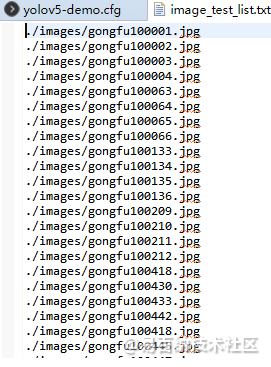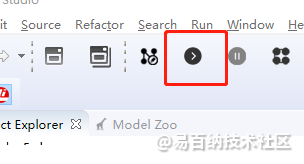Hi3516(海思)训练yolov5-6.0-->转oonx-->转caffe-转.wk文件
Hi3516(海思)训练yolov5-6.0—>转oonx—>转caffe-转.wk文件
1 训练
1 更改模型结构,将Upsample变成ConvTranspose2d,
# YOLOv5 v6.0 head
head:
[[-1, 1, Conv, [512, 1, 1]],
# [-1, 1, nn.Upsample, [None, 2, 'nearest']],
[-1, -1, nn.ConvTranspose2d,[256, 256, 2, 2]],
[[-1, 6], 1, Concat, [1]], # cat backbone P4
[-1, 3, C3, [512, False]], # 13
[-1, 1, Conv, [256, 1, 1]],
# [-1, 1, nn.Upsample, [None, 2, 'nearest']],
[-1, -1, nn.ConvTranspose2d,[128, 128, 2, 2]],
[[-1, 4], 1, Concat, [1]], # cat backbone P3
[-1, 3, C3, [256, False]], # 17 (P3/8-small)
2. 导出模型
1. 导出onnx模型:
(1) 在export中opset改为9
(2) 在models/yolo.py中修改detect中代码如下:
# 为海思3561dv300更改 train use 官方
class Detect(nn.Module):
stride = None # strides computed during build
onnx_dynamic = False # ONNX export parameter
def __init__(self, nc=80, anchors=(), ch=(), inplace=True): # detection layer
super().__init__()
self.nc = nc # number of classes
self.no = nc + 5 # number of outputs per anchor
self.nl = len(anchors) # number of detection layers
self.na = len(anchors[0]) // 2 # number of anchors
self.grid = [torch.zeros(1)] * self.nl # init grid
self.anchor_grid = [torch.zeros(1)] * self.nl # init anchor grid
self.register_buffer('anchors', torch.tensor(anchors).float().view(self.nl, -1, 2)) # shape(nl,na,2)
self.m = nn.ModuleList(nn.Conv2d(x, self.no * self.na, 1) for x in ch) # output conv
self.inplace = inplace # use in-place ops (e.g. slice assignment)
def forward(self, x):
# print_feature=2
z = [] # inference output
for i in range(self.nl):
x[i] = self.m[i](x[i]) # conv
bs, _, ny, nx = x[i].shape # x(bs,255,20,20) to x(bs,3,20,20,85)
# x[i] = self.m[i](x[i]) # **增加这行代码**
# x[i] = x[i].view(bs, self.na, self.no, ny, nx).permute(0, 1, 3, 4, 2).contiguous()
x[i] = x[i].view(bs, self.na, self.no, ny*nx)
if not self.training: # inference
if self.grid[i].shape[2:4] != x[i].shape[2:4] or self.onnx_dynamic:
self.grid[i], self.anchor_grid[i] = self._make_grid(nx, ny, i)
# y = x[i].sigmoid()
y = x[i]
# if self.inplace:
# y[..., 0:2] = (y[..., 0:2] * 2. - 0.5 + self.grid[i]) * self.stride[i] # xy
# y[..., 2:4] = (y[..., 2:4] * 2) ** 2 * self.anchor_grid[i] # wh
# else: # for YOLOv5 on AWS Inferentia https://github.com/ultralytics/yolov5/pull/2953
# xy = (y[..., 0:2] * 2. - 0.5 + self.grid[i]) * self.stride[i] # xy
# wh = (y[..., 2:4] * 2) ** 2 * self.anchor_grid[i] # wh
# y = torch.cat((xy, wh, y[..., 4:]), -1)
# z.append(y.view(bs, -1, self.no))
z.append(y)
return z
# return x if self.training else (torch.cat(z, 1), x)
def _make_grid(self, nx=20, ny=20, i=0):
d = self.anchors[i].device
yv, xv = torch.meshgrid([torch.arange(ny).to(d), torch.arange(nx).to(d)])
grid = torch.stack((xv, yv), 2).expand((1, self.na, ny, nx, 2)).float()
anchor_grid = (self.anchors[i].clone() * self.stride[i]) \
.view((1, self.na, 1, 1, 2)).expand((1, self.na, ny, nx, 2)).float()
return grid, anchor_grid
# 官方原先的DETAECT
class Detect1(nn.Module):
stride = None # strides computed during build
onnx_dynamic = False # ONNX export parameter
def __init__(self, nc=80, anchors=(), ch=(), inplace=True): # detection layer
super().__init__()
self.nc = nc # number of classes
self.no = nc + 5 # number of outputs per anchor
self.nl = len(anchors) # number of detection layers
self.na = len(anchors[0]) // 2 # number of anchors
self.grid = [torch.zeros(1)] * self.nl # init grid
self.anchor_grid = [torch.zeros(1)] * self.nl # init anchor grid
self.register_buffer('anchors', torch.tensor(anchors).float().view(self.nl, -1, 2)) # shape(nl,na,2)
self.m = nn.ModuleList(nn.Conv2d(x, self.no * self.na, 1) for x in ch) # output conv
self.inplace = inplace # use in-place ops (e.g. slice assignment)
def forward(self, x):
z = [] # inference output
for i in range(self.nl):
x[i] = self.m[i](x[i]) # conv
bs, _, ny, nx = x[i].shape # x(bs,255,20,20) to x(bs,3,20,20,85)
x[i] = x[i].view(bs, self.na, self.no, ny, nx).permute(0, 1, 3, 4, 2).contiguous()
if not self.training: # inference
if self.grid[i].shape[2:4] != x[i].shape[2:4] or self.onnx_dynamic:
self.grid[i], self.anchor_grid[i] = self._make_grid(nx, ny, i)
y = x[i].sigmoid()
if self.inplace:
y[..., 0:2] = (y[..., 0:2] * 2. - 0.5 + self.grid[i]) * self.stride[i] # xy
y[..., 2:4] = (y[..., 2:4] * 2) ** 2 * self.anchor_grid[i] # wh
else: # for YOLOv5 on AWS Inferentia https://github.com/ultralytics/yolov5/pull/2953
xy = (y[..., 0:2] * 2. - 0.5 + self.grid[i]) * self.stride[i] # xy
wh = (y[..., 2:4] * 2) ** 2 * self.anchor_grid[i] # wh
y = torch.cat((xy, wh, y[..., 4:]), -1)
z.append(y.view(bs, -1, self.no))
return x if self.training else (torch.cat(z, 1), x)
def _make_grid(self, nx=20, ny=20, i=0):
d = self.anchors[i].device
yv, xv = torch.meshgrid([torch.arange(ny).to(d), torch.arange(nx).to(d)])
grid = torch.stack((xv, yv), 2).expand((1, self.na, ny, nx, 2)).float()
anchor_grid = (self.anchors[i].clone() * self.stride[i]) \
.view((1, self.na, 1, 1, 2)).expand((1, self.na, ny, nx, 2)).float()
return grid, anchor_grid
改动有以下几点:
1:去掉了原先的permute;
2:将view原来的输出维度(bs, na, no, ny, nx) 改为 (bs, na, no, ny * nx);
3:去除了后处理坐标点和宽高decode代码,去除cat操作
现在来分析下为什么这么改:
1:nnie不支持5个维度的permute(即transpose),且只支持0231的方式,过于局限,我们不妨删掉这一层,在后处理中按照合适的读取方式去找结果就好了。
2:nnie的reshape也只支持4维,且第一维必须是0,为了能用nnie的reshape,我们不得不把x和y共享一个维度,这导致的结果是输出结果中,x和y在同一行,我们只需按个数取值即可。
3:后处理中,对三个检测层分别处理,所以不需要concat
执行
python export.py --opset 9 --imgsz 640 640 --simplify --weights best.pt
导出onnx-sim模型
python -m onnxsim xxx.onnx xxx-sim.onnx
3 转caffe
github上搜索 yolov5_onnx2caffe 项目(https://github.com/Wulingtian/yolov5_onnx2caffe)
vim convertCaffe.py
设置onnx_path(上面转换得到的onnx模型),prototxt_path(caffe的prototxt保存路径),caffemodel_path(caffe的caffemodel保存路径)
执行
python ./yolov5_onnx2caffe/convertCaffe.py
4 caffe转 wk文件

2

注意将.cfg文件中compile_mode = 0 改成compile_mode = 1

说明:
image_list 字段表示测试的数据,具体如下


点击运行

- 分享
- 举报
 暂无数据
暂无数据-
浏览量:3161次2024-02-19 15:26:47
-
2024-01-22 16:01:53
-
浏览量:9158次2020-11-24 23:21:01
-
2023-01-04 15:09:58
-
浏览量:6198次2022-03-03 09:00:09
-
浏览量:5869次2021-12-11 15:15:29
-
浏览量:6674次2020-08-26 14:15:06
-
浏览量:4340次2020-08-06 15:57:44
-
浏览量:5662次2023-10-13 17:55:36
-
浏览量:2847次2024-02-23 17:41:04
-
浏览量:2596次2024-02-18 16:38:33
-
浏览量:1278次2024-01-22 15:27:25
-
浏览量:4879次2020-08-05 20:38:05
-
浏览量:5672次2024-05-22 15:23:49
-
浏览量:46213次2019-07-25 11:31:42
-
浏览量:2447次2024-01-06 10:33:06
-
浏览量:1246次2023-06-03 16:03:04
-
浏览量:5088次2017-10-30 11:12:34
-
浏览量:3577次2024-03-05 15:34:48
- 基于海思wifi平台Hi3861开发(2) -- SDK开发篇
- 海思Hi3559AV100/Hi3519AV100 NNIE深度学习模块开发与调试记录
- 海思|在家也能“乘风破浪”?
- 超高清 | HDR Vivid之标准深度解读
- 涨知识 | 哇!理解PLC电力载波通信一点都不难!
- [HarmonyOS之旅] Chapter4 - HarmonyOS启动流程
- EMC辐射整改案例-车载显示屏流媒体EMI辐射严重超标整改分享
- Hi3516DV300三天入门之---(四)文件系统制作(2)
- docker中挂载samba目录时报错Unable to apply new capability set.
- 【海思HI3520之QT开发】-串口通讯实战(二):串口通讯之TTL通讯
-
广告/SPAM
-
恶意灌水
-
违规内容
-
文不对题
-
重复发帖
shui





 微信支付
微信支付举报类型
- 内容涉黄/赌/毒
- 内容侵权/抄袭
- 政治相关
- 涉嫌广告
- 侮辱谩骂
- 其他
详细说明



 微信扫码分享
微信扫码分享 QQ好友
QQ好友





